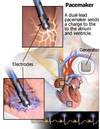Anatomy review, Stress testing, Pacemakers Exam #1 Flashcards
Purpose of a stress test: What is it that’s being stressed?
compare resting baseline to post-exercise Cardiovascular system, usually cardiac profusion
Name five Methods/Types of stress tests:
Harvard step test Treadmill Bicycle or arm ergometry Toe raises Walking a prescribed distance Medications Active plantar flexes
Why so many different protocols for stress testing?
We need accommodate our patients’ varying physical conditions.
Indications for Stress Testing
Angina Suspected CAD Detection of exercise-induced arrhythmias Evaluation of cardiac function Vascular lab: evaluate LE arterial disease Evaluation of therapy Sports medicine
Which method of stress testing is most common?
Tredmill (TM)
What is a stress test?
Exercise used to induce ischemia Exercise is increased until a “target” heart rate is achieved Stressing the patient is a provocative measure;we want to provoke symptoms if they are there(angina, claudication, etc.)to disclose disease.It must be done with caution.
What is MVO2?
Myocardial oxygen demand (MVO2) Oxygen is demanded by the heart during systole Oxygen is supplied to the heart during diastole If the supply of oxygen does not meet MVO2 , ischemia will result
inotropic state:
to do with strength of myocardial contraction
Stress induced ischemia will (may) reveal the presence of
CAD
At rest, myocardial oxygen demand is:
low
With exertion and increased heart activity, myocardial oxygen demand is:
high
What is CAD?
Coronary Artery Disease
Small problem with TM testing: How severe must plaque be to cause M.I.?
It’s looking as if plaques don’t have to be hemodynamically significant to cause M.I.According to at least one recent study, many or most M.I.s result from plaques less than 50%that thrombose and cause acute occlusion.
Define ischemia.
lack of O2
In the cardiac cycle, when is O2 demand created, and when is it satisfied?
the demand is created in systole and is satisfied in diastole because that is when the heart is profused
What causes it CAD?
Build up of plaque Narrowing of coronary artery lumen Reduces blood flow to myocardium Increases probability of blood clot formation
What is the usual mechanism of M.I.?
Plaque surface eroding and thrombosing at the site. mechanism of tissue getting ischemic and dying. plaque ruptures, thrombosis and causes a sudden total occlusion.
What implication does that have for the utility of stress testing?
it means that if the plaque is not hemodynamically significant then it will not show up on a stress test.
Ischemia
Insufficient supply of oxygen to the tissue
TPA
desolves clots
How is cardiac ischemia detected during stress testing?
ST segment changes ST depression of 2mm ST elevation of 1 mm ST slope T-wave inversion
What is the J point?
Where QRS endsand ST segment begins.Sometimes difficult to spot.
Basic Concept of Stress Testing
Increase MVO2 and watch for indication of ischemia Ischemia indicates that the demand for oxygen exceeds the coronary system’s ability to supply oxygen Detects the presence of CAD


















































































